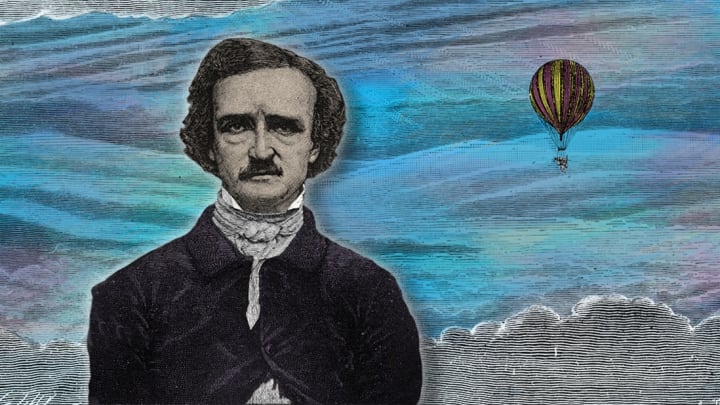When Edgar Allan Poe Pranked New York City—And Inspired Jules Verne

On April 13, 1844, a special extra of the New York Sun announced: “ASTOUNDING NEWS! … THE ATLANTIC CROSSED IN THREE DAYS! SIGNAL TRIUMPH OF MR. MONCK MASON’S FLYING MACHINE!!!” According to the article, a balloon heading from England toward Paris had been blown off-course and landed safely near Charleston, South Carolina. The “report” was submitted by a journalist who was also a well-known short-story writer: Edgar Allan Poe.
There was just one problem. He had made the whole thing up.
“The Balloon Hoax,” as it later became known, was Poe’s idea of a calling card. He had just moved to Manhattan, looking for work as a journalist. What better way to announce you’ve arrived than to prank an entire city?
The possibility of balloon travel had ignited the popular imagination since the 1780s, when the Montgolfier brothers built the first balloon to carry a man into the air. By the 1830s, balloonists had successfully crossed the British Channel, and they had begun talking about attempts to cross the Atlantic in earnest.
Newspapers were often full of the exploits of daring aeronauts, and the interest in ballooning apparently led to some fictional takes on the pursuit. Poe’s story in The Sun wasn’t the first: In 1835, Richard Adams Locke published a widely credited account of a balloon reaching the moon. The success infuriated Poe, who had just two months earlier published a story about a man returning from the moon in a balloon, “Hans Pfaall—A Tale.” Poe was certain Locke had plagiarized him, but Locke received all the glory for his “Moon Hoax.” (Ironically, Poe’s own hoax included long sections from the aeronaut Thomas Monck Mason’s 1836 account of his balloon voyage from England to Germany.) Poe decided he would do a little self-promotion while outdoing his old enemy: He submitted the hoax to the same paper that had published Locke’s. The paper published the account with glee, completely unaware that it was fake.
According to Poe's report, a balloon called the Victoria held eight people and made the crossing in 75 hours. At the time, it took two weeks to cross the Atlantic by boat, so the potential for a voyage in which “the broad Atlantic becomes a mere lake,” as one of the passengers supposedly remarked, created quite a stir. Poe later claimed that when the Sun first announced the special Extra with details of the fantastic voyage, “the whole square surrounding the Sun building was literally besieged … I never witnessed more intense excitement to get possession of a newspaper. As soon as copies made their way into the streets, they were bought up, at almost any price, from the newsboys.”
Poe included an abundance of scientific detail to give the article an air of authority, from precise measurements of key components, down to the screws and steel wires, to the combined weight of the fictional passengers (1200 pounds). His main characters were also based on real people: Poe named the pilot after Monck Mason, the famed aeronaut whose accounts he had liberally borrowed from.
The report was picked up in the next day's New York Sunday Times (no connection to The New York Times, which had yet to be founded) and Baltimore Sun. Other papers were less convinced of the report's veracity, and seemed to realize that further news should have come up from Charleston. (One contemporary account suggests that Poe himself revealed the hoax by drunkenly boasting about it in front of the crowd at the newspaper’s headquarters.)
Two days after the hoax first appeared, the New York Sun published a retraction. "The mails from the South last Saturday night not having brought a confirmation of the arrival of the Balloon from England ... we are inclined to believe that the intelligence is erroneous," the paper said. However, they added, "We by no means think such a project impossible." Astoundingly, balloonists would not truly accomplish a trans-Atlantic flight until 1978.
Poe believed his little trick would demonstrate his mastery of scientific description and artful writing. He was so assured of his skill, he didn’t seem to realize that publishing known misinformation would hurt his chances of finding work as a journalist—which is exactly what happened.
But the hoax did inspire someone else: Jules Verne later read it and began working on the adventure that would first bring him fame, Five Weeks in a Balloon, published in 1863. That tale was an immediate success, earning him the financial independence that would allow him to go on to write blockbusters such as A Journey to the Center of the Earth and Around the World in Eighty Days. Whether Poe would have appreciated Verne’s achievements, so heavily influenced by his own work, is another matter.